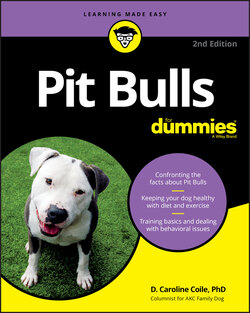Читать книгу Pit Bulls For Dummies - D. Caroline Coile - Страница 17
Becoming America’s Sweetheart
ОглавлениеIn the early 20th century, Pit Bulls moved graciously from fame as pit fighters to fame as national symbols. The Pit Bull’s reputation for courage and tenacity, combined with his good nature, made him a natural as the dog synonymous with the United States during World War I. A popular war poster of the period aptly captures the true Pit Bull outlook by showing a picture of a Pit Bull wearing an American flag bandana above the phrase “I’m neutral, but not afraid of any of them.” Another poster featured a Pit Bull named Tige, who was the companion of the then-popular cartoon character Buster Brown. (Buster Brown and Tige also represented Buster Brown shoes in advertisements.)
In fact, a possible Pit Bull (or Pit Bull mix or Boston Terrier mix — nobody knows for sure) named Stubby emerged from World War I as a national hero. Stubby was the unofficial mascot of the 102nd infantry, and when it came time to go overseas, the men smuggled him on board. Despite no training or experience in battle conditions, Stubby braved intense shelling to comfort wounded soldiers lying in the crossfire. He eventually served for 18 months and participated in 17 battles. Stubby repeatedly warned his regiment of incoming mortar shells and mustard gas attacks, and once he even prevented a spy from escaping. When Stubby was wounded, he played the role of therapy dog, cheering hospitalized soldiers. Even while recuperating in Paris, he was credited with saving a child from being run over.
Stubby was decorated by General Pershing, awarded the rank of honorary sergeant, and received by three presidents. He led more parades than any dog in history. Upon Stubby’s death in 1926, his hide was mounted over a plaster form of his body, with an urn containing his ashes inside. He was displayed wearing a medal-covered coat, first at the Red Cross Museum and then at the Smithsonian Institute. Until recently, Stubby was largely forgotten, packed away in a crate in a back room of the Smithsonian. But in 2018, an animated movie about him renewed interest and Stubby is back on exhibition at the Smithsonian National Museum of American History.
The next Pit Bull to capture America’s heart was Petey of The Little Rascals and Our Gang movie fame. Actually, Petey had already starred in several Buster Brown movies (as Tige) before becoming one of the most popular Rascals of all time. When the original Petey died, he was replaced with another Petey, an American Staffordshire Terrier registered as Lucenay’s Peter. Whatever his role, Pete the Pup exemplified the Pit Bull in his role as a roguish buddy, furthering the breed’s appeal.
Popular with families and welcomed throughout neighborhoods, the Pit Bull basked in his reputation as a fun-loving and patient member of the family.
This is not to say that things were always rosy, however. As far back as the late 1800s and early 1900s, breed bans were put in place against “bulldogs,” as they were called in several cities, including Washington, D.C. Although people tend to think of Pit Bull attacks as a more recent trend, around the turn of the twentieth century, they had already been in the news for killing people, with many reporters calling for their banishment.
